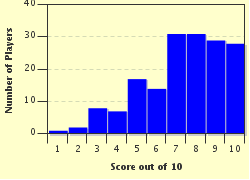Quiz Answer Key and Fun Facts
1. The scrum is an extremely important part of rugby union and a good scrum can boost team morale. There are many infringements in the sport that can lead to a scrum but which of the following is one such infringement?
2. There are eight men or women per team in a typical 15-a-side match of rugby union that partake in scrummaging. However, at what position is a competitor playing in if they are responsible for competing for a ball in a scrum immediately after the feed? This player is usually assigned the number 2 jersey and often throws the ball in at the line-out.
3. There are many player positions in the game of rugby including inside centre, outside centre and scrum half. These positions all have specific jobs on the field of play, but which of the following is the actual name of a rugby position?
4. The rugby union scrum is essentially a power struggle between the two opposing teams, the stronger side will dominate. However, there are certain actions that will give a team an unfair advantage such as feeding the ball into the scrum at an angle. If this is spotted by the referee then what is the official sanction?
5. In a rugby union scrum, what is the name given to the space between opposition front rows through which the ball is fed?
6. In rugby union, a line-out is a method of returning a dead ball into play. The line-out takes place between 5m to 15m from the touch line, which is the line from which a player throws the ball back in to be caught. How far from the touch line are scrums formed if there is an infringement during the line-out?
7. In the sport of rugby union, scrums can only be formed at certain parts of the playing enclosure. Can a scrum be formed in the in-goal area?
8. If a front row player is given a red card, that player is out for the rest of the game. The substitution rules allow the team to substitute one of the players that have not been sent off in order to allow another front row player on to the field. What happens at the next scrum if there are no trained front row players available to take the place of the man or woman given a red card?
9. Whilst a scrum is taking place on the rugby pitch, all players that are not taking part in the scrum must stand behind an offside line. How far back from the hindmost foot of one's hindmost player in a scrum must such players stand to be considered onside?
10. Due to problems at the scrum, a directive was applied (until mid-2013) which stated that the referee had to call out the four phases of the scrum. In what order were the phases?
Source: Author
jonnowales
This quiz was reviewed by FunTrivia editor
Nightmare before going online.
Any errors found in FunTrivia content are routinely corrected through our feedback system.

